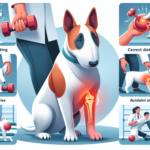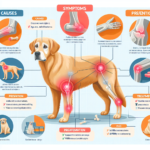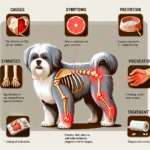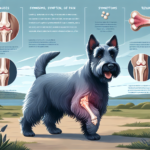Miniature Bull Terrier Joint Pain: Causes, Symptoms, Prevention, and Treatment

Introduction
The Miniature Bull Terrier is a distinctive and charismatic breed known for its egg-shaped head, muscular build, and spirited personality. Originating in the 19th century, this breed was developed in England by crossing the Bulldog with the now-extinct White English Terrier. The goal was to create a smaller, more agile version of the Bull Terrier that retained its tenacity and courage. Today, the Miniature Bull Terrier is cherished as a loyal companion and show dog, recognized for its playful and affectionate nature.
Like many purebred dogs, the Miniature Bull Terrier is prone to certain health issues. Among these, joint pain is a significant concern that can affect the breed’s quality of life. Joint health is crucial for maintaining the mobility and overall well-being of these active and energetic dogs. Understanding the causes, symptoms, prevention, and treatment of joint pain in Miniature Bull Terriers is essential for responsible pet ownership.
Breed-Specific Joint Pain Risks
Genetic Predisposition
Miniature Bull Terriers, like many other breeds, have a genetic predisposition to joint-related issues. Conditions such as hip dysplasia, elbow dysplasia, and arthritis are more common in this breed due to inherited traits. Hip dysplasia, in particular, is a concern where the hip joint does not fit properly into the hip socket, leading to pain and mobility issues. Elbow dysplasia involves abnormal development of the elbow joint, causing lameness and discomfort. Arthritis, a degenerative joint disease, can also develop as the dog ages, leading to chronic pain and stiffness.
Age-Related Risks
As Miniature Bull Terriers age, the risk of developing joint pain increases. While young dogs may show few signs of joint issues, older dogs are more susceptible to conditions like arthritis. Typically, joint pain becomes more noticeable in Miniature Bull Terriers around the age of 5 to 7 years. However, early-onset joint issues can occur, especially if the dog has a genetic predisposition or has experienced joint trauma.
Activity Level and Joint Stress
Miniature Bull Terriers are known for their high energy levels and playful nature. While regular exercise is essential for their overall health, excessive or inappropriate activity can put stress on their joints. Activities that involve jumping, running on hard surfaces, or sudden changes in direction can exacerbate joint issues. Owners should be mindful of their dog’s activity level and ensure that exercise routines are appropriate for their age and physical condition.
Common Symptoms of Joint Pain in Miniature Bull Terriers
General Symptoms
- Limping: One of the most noticeable signs of joint pain is limping or favoring one leg over another.
- Stiffness: Dogs with joint pain may exhibit stiffness, especially after resting or sleeping.
- Reluctance to Move: A dog experiencing joint pain may be hesitant to engage in physical activities, such as climbing stairs or jumping onto furniture.
- Decreased Activity: A reduction in overall activity levels and playfulness can indicate joint discomfort.
- Behavioral Changes: Irritability, aggression, or withdrawal can be signs of chronic pain.
Breed-Specific Symptoms
In Miniature Bull Terriers, joint pain may manifest in specific ways. Due to their muscular build, they may show a noticeable change in gait or posture. Additionally, they might exhibit a reluctance to engage in activities they previously enjoyed, such as playing fetch or going for long walks. Owners should be vigilant for any changes in their dog’s behavior or physical abilities.
When to Consult a Vet
If a Miniature Bull Terrier shows any signs of joint pain, it is crucial to consult a veterinarian promptly. Early intervention can prevent the progression of joint issues and improve the dog’s quality of life. Owners should seek veterinary advice if their dog exhibits persistent limping, stiffness, or reluctance to move, or if there are any sudden changes in behavior or activity levels.
Preventive Measures for Joint Health
Exercise Recommendations
Regular, moderate exercise is essential for maintaining joint health in Miniature Bull Terriers. Activities such as walking, swimming, and gentle play can help keep their joints flexible and muscles strong. Owners should avoid high-impact activities that can strain the joints, such as excessive jumping or running on hard surfaces. It is also important to provide a balanced exercise routine that includes both physical and mental stimulation.
Dietary Suggestions
A well-balanced diet is crucial for supporting joint health in Miniature Bull Terriers. Owners should consider feeding their dogs high-quality commercial dog food that meets their nutritional needs. Additionally, certain supplements can promote joint health, including:
- Glucosamine and Chondroitin: These supplements can help maintain cartilage health and reduce inflammation.
- Omega-3 Fatty Acids: Found in fish oil, these fatty acids have anti-inflammatory properties that can benefit joint health.
- Antioxidants: Vitamins C and E can help reduce oxidative stress and support overall joint health.
Weight Management
Maintaining a healthy weight is critical for reducing joint stress in Miniature Bull Terriers. Excess weight can exacerbate joint issues and lead to additional health problems. Owners should monitor their dog’s weight and adjust their diet and exercise routine as needed to prevent obesity. Regular veterinary check-ups can help ensure that the dog remains at an optimal weight.
Early Screening and Monitoring
Early screening and monitoring can help detect joint issues before they become severe. Owners should consider regular veterinary check-ups that include joint assessments. Additionally, genetic testing can identify predispositions to joint conditions, allowing for early intervention and preventive measures. Monitoring the dog’s activity levels and behavior can also help catch early signs of joint pain.
Treatment Options for Joint Pain
Non-Surgical Treatments
For Miniature Bull Terriers with joint pain, non-surgical treatments can provide significant relief. These may include:
- Medications: Nonsteroidal anti-inflammatory drugs (NSAIDs) can help reduce pain and inflammation. Other medications, such as pain relievers and joint supplements, may also be prescribed.
- Physical Therapy: Physical therapy can improve joint mobility and strengthen muscles. Techniques such as hydrotherapy, massage, and controlled exercises can be beneficial.
- Lifestyle Adjustments: Modifying the dog’s activity level and providing a comfortable living environment can help manage joint pain. This may include using ramps, orthopedic beds, and avoiding activities that strain the joints.
Surgical Options
In severe cases of joint pain, surgical intervention may be necessary. Common surgical options for Miniature Bull Terriers include:
- Joint Replacement: Hip or elbow replacement surgery can provide significant relief for dogs with severe joint damage.
- Arthroscopy: This minimally invasive procedure can help diagnose and treat joint issues by removing damaged tissue or repairing joint structures.
- Osteotomy: This surgical procedure involves cutting and realigning bones to improve joint function and reduce pain.
Alternative Therapies
Alternative therapies can complement traditional treatments and provide additional relief for joint pain. These may include:
- Acupuncture: Acupuncture can help reduce pain and inflammation by stimulating specific points on the body.
- Hydrotherapy: Water-based exercises can improve joint mobility and reduce pain without putting stress on the joints.
- Massage: Therapeutic massage can help relax muscles, improve circulation, and reduce pain.
Lifestyle and Management Tips
Daily Care Routine
A consistent daily care routine can help manage and alleviate joint pain in Miniature Bull Terriers. This may include:
- Providing regular, moderate exercise tailored to the dog’s abilities.
- Feeding a balanced diet with joint-supporting supplements.
- Maintaining a healthy weight through portion control and regular exercise.
- Monitoring the dog’s behavior and activity levels for any signs of discomfort.
- Ensuring regular veterinary check-ups and following the vet’s recommendations.
Modifying the Home Environment
Making the home environment more comfortable for a dog with joint pain can significantly improve their quality of life. Consider the following modifications:
- Using ramps or steps to help the dog access furniture or climb stairs.
- Providing orthopedic beds that offer better support for joints.
- Ensuring that the dog’s living area is free of slippery surfaces to prevent falls.
- Creating a quiet, comfortable space where the dog can rest undisturbed.
Long-Term Management
Long-term management strategies are essential for keeping a Miniature Bull Terrier active and happy despite joint pain. These may include:
- Continuing regular exercise and physical therapy to maintain joint mobility.
- Adjusting the dog’s activity level as needed to prevent overexertion.
- Providing ongoing pain management through medications or alternative therapies.
- Maintaining regular veterinary check-ups to monitor the dog’s condition and adjust treatment plans as necessary.
FAQs About Miniature Bull Terriers and Joint Pain
What are the early signs of joint pain in Miniature Bull Terriers?
Early signs of joint pain in Miniature Bull Terriers include limping, stiffness, reluctance to move, decreased activity levels, and behavioral changes such as irritability or withdrawal.
Can joint pain in Miniature Bull Terriers be prevented?
While it may not be possible to completely prevent joint pain, owners can take preventive measures such as providing regular, moderate exercise, maintaining a healthy weight, feeding a balanced diet with joint-supporting supplements, and ensuring regular veterinary check-ups.
Are there specific exercises that are better for Miniature Bull Terriers with joint pain?
Low-impact exercises such as walking, swimming, and gentle play are ideal for Miniature Bull Terriers with joint pain. These activities help maintain joint mobility and muscle strength without putting excessive stress on the joints.
What dietary supplements can help support joint health in Miniature Bull Terriers?
Supplements such as glucosamine, chondroitin, omega-3 fatty acids, and antioxidants (vitamins C and E) can support joint health by maintaining cartilage, reducing inflammation, and minimizing oxidative stress.
When should I consult a vet about my Miniature Bull Terrier’s joint pain?
Owners should consult a veterinarian if their Miniature Bull Terrier exhibits persistent limping, stiffness, reluctance to move, or any sudden changes in behavior or activity levels. Early intervention can prevent the progression of joint issues and improve the dog’s quality of life.
Conclusion
Joint pain is a significant concern for Miniature Bull Terriers, but with proper care and attention, owners can help their dogs lead active and comfortable lives. By understanding the causes, symptoms, prevention, and treatment options for joint pain, owners can take proactive steps to support their dog’s joint health. Regular veterinary check-ups, a balanced diet, appropriate exercise, and a comfortable living environment are essential components of managing joint pain in this breed. By staying informed and vigilant, owners can ensure their Miniature Bull Terriers enjoy a happy and healthy life.




